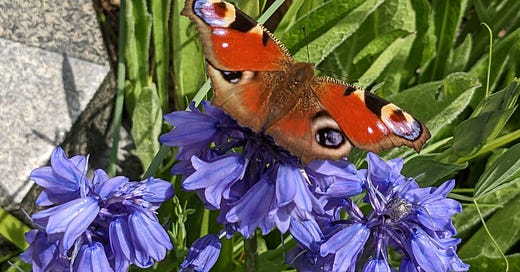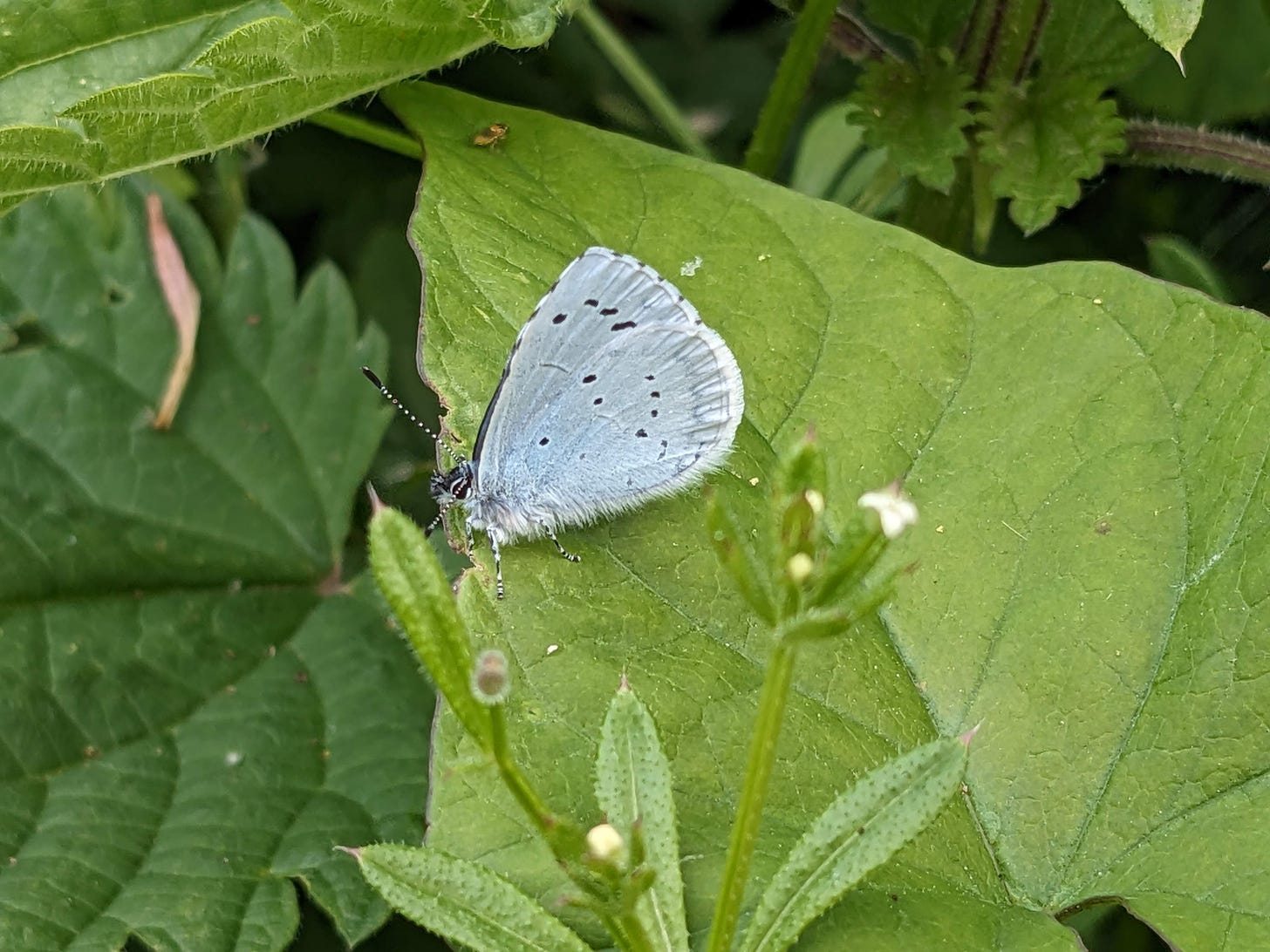For almost half a century, thousands of people have been walking set routes, known as transects, every week between April and September and recording the number of butterflies they see. Or, at least they do, if the weather conditions are right. Too wet, cold or windy and the butterflies won’t be flying so there’s no point doing a transect. Regular transects are carried out during this six-month period as that’s when the weather conditions are most likely to be right but, of course, the butterflies don’t take any notice of the calendar. They start appearing as soon as the weather is warm and sunny enough.
This year I saw my first butterfly on 15 February – a bright yellow Brimstone enjoying the spring sunshine in King’s Wood but then we had weeks when it rained pretty much every day and I didn’t see another until 26 March – also a Brimstone, this time in Regent’s Park. The first butterfly I saw in April was a Peacock feasting on Red Deadnettle in Rainham Marshes in Essex. Both Brimstones and Peacocks are among the few species which overwinter in the UK as adults, so they’re often the first to appear as temperatures rise in Spring.
I’m one of the many regular butterfly counters, but I share responsibility for a transect at One Tree Hill and Brenchley Gardens in South London, so each of us does the survey about once a month rather than every week. It’s my turn on the rota again this week and as usual as my turn approaches, I have been scanning the weather forecast anxiously trying to identify which days are most likely to have the right conditions. There are occasional weeks when the weather conditions don’t allow for a survey at all which is always a disappointment but still provides useful evidence. Fortunately it looks as though most of this week will be dry and sunny.
The records from our transects at One Tree Hill, along with those from across the country are collated and analysed by Butterfly Conservation and the combined data provides a picture of the changing fortunes of butterflies over time and across the country. Sadly, it’s not always a pretty picture. Butterflies are an indicator species, their presence – and the numbers of different species – providing an indication of the health of a habitat. And providing the right habitats for butterflies isn’t always straightforward, as they often have different requirements at different stages of their lifecycle. While adult Peacocks are particularly fond of Buddleia, a shrub which is often specifically planted for its ability to attract butterflies, their caterpillars eat the leaves of stinging nettles, a much less popular plant.
Since getting involved in the transect I have started to take much more notice of the wider impacts of different weather conditions. The cool, wet weather last summer was the most challenging for finding a good time to survey – a complete contrast to 2018, the year we started the transect at One Tree Hill. The weeks of warm, sunny weather then meant we could pretty much pick any day we wanted but drought brings its own challenges. We recorded good numbers of butterflies in the early months of the 2018 season but after weeks without rain the numbers began to drop as the plants the butterflies feed on shrivelled and died.
Drought can have a devastating impact in subsequent years too if it results in fewer of the plants that butterflies lay their eggs on, or if those plants don’t survive to provide sustenance for the caterpillars when they emerge. Butterfly numbers have never recovered to what they were prior to the extended drought of 1976 – a fact which still shocks me every time I read or hear it. Fortunately, it seems that the hotter summers that have occurred with increasing frequency recently don’t seem to have had quite as much impact, but the longer-term trends are worrying. There has been a fall in the numbers of many common butterflies, including species such as Gatekeepers, Meadow Browns, and Speckled Woods which are some of the ones we would expect to see most frequently at One Tree Hill later in the summer.
I walked my first transect this year in the second week of April, on a pleasantly warm, sunny Spring afternoon. Aside from being a little windy, it was near perfect conditions for butterflies, so when I didn’t see any in the first section of the transect, I could feel my anxiety start to rise. But then they began to appear, and I was able to record a good mixture of different species including some such as Orange-Tip, Speckled Wood and Holly Blue, that were my first sightings of the year. There were also several Brimstones, a few Whites (large and small) and a single Comma basking in the sunshine - 25 in total. Not huge numbers compared to the counts in some other places but a good start to the season for a heavily used urban site which is still recovering from all the extra visitors it got during lockdown.
When I am not worrying about where the butterflies have gone, there is something almost meditative about walking the transect, about being out in a greenspace with a definite purpose but walking far more slowly than I usually would and paying very close attention to what’s around me. I usually return home feeling calmer than when I arrived, especially when I do see good numbers of butterflies or spot something else that gives me a sense of hope. This time, I saw two patches of Wood Anemones - glimpses of the ancient woodland that once covered this area - including one in a place where I’ve never seen them before. When I noticed the other patch for the first time in 2021, someone had picked most of the flowers and scattered them across the path for some reason! Fortunately, that doesn’t seem to have done the Wood Anemones any long-time harm and this year they were left to grow in peace. A sign perhaps that One Tree Hill is finally starting to recover from being loved half to death during the pandemic.
To finish….
Butterflies through Time: This webinar organised by the Biological Recording Company provided an overview of research by Dr Matt Hayes into the impact of the changing climate on butterflies which has come up with some fascinating, though deeply worrying, results. The first half covered research undertaken during the 2022 heatwave which found that the very hot weather actually led to reduced activity among butterflies, showing that even these sun-looking insects may suffer as temperatures rise. In the second half Dr Hayes described how he is using historical specimens and records by 19th century naturalists to identify changes in the abundance of species.
Big Butterfly Count: This is an annual opportunity for everyone to get involved in counting butterflies wherever they happen to be and this year it takes place from 12 July to 4 August. There’s lots of information about it on the Butterfly Conservation website includes links to ID charts and an app which you can use to record your sightings.
Letter from Enlli: The reason this post is so late is that I spent the last week of April on a writing course on Ynys Enlli (known as Bardsey Island in English), a tiny island off the coast of North Wales. It was an amazing experience and I plan to write more about it for my next post but in the meantime you can read my Letter from Enlli which was published on Nation Cymru yesterday.







New subscriber saying "Hi" here 😊
I was drawn to this piece, as we have been adding Brimstone food sources to the planting of our 12acre field that we're planting as (hopefully) a little sanctuary for wildlife. We see only a few early Brimstones each year, they are my joyous harbingers of spring, so we're hoping to nurture more in the future.
We have lots of nettles on the edges of our field and it's wonderful to spot a patch that's writhing with ravenous caterpillars.
But, this year I've seen a marked reduction in numbers of butterflies and other insects, despite our efforts. A sobering time.
Enjoyed reading about your experiences of surveying butterflies! This is exactly what I'll be posting about later this week!